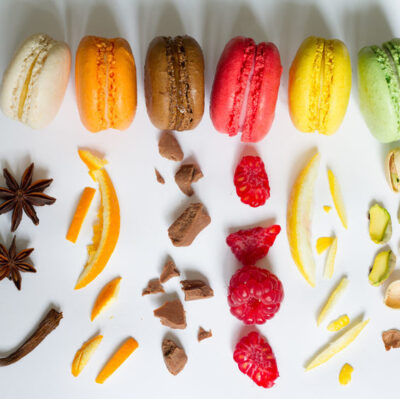Origin
Flavorings, such as spices, have been used to improve the taste of food since ancient times. In the 1800s, the Germans and Swiss were the first to derive flavor substances naturally found in food and significantly expanded the flavor market.1
Prior to World War II, most flavor manufacturers were small businesses blending essential oils, aroma chemicals and adjuvants or resellers. Then in the 1960s, instrumentation became available that could isolate and identify flavor ingredients present in foods in trace quantities. These advances propelled the industry into what it is today.
Function
Manufactured flavors typically contain the aroma, taste and sensate components that make a food more desirable. For example:
- A cookie or cake mix manufacturer may want to add a butter, almond or vanilla flavor to add character.
- A fruit filling manufacturer may want to add fruit flavor (apple, lemon, cherry, etc.) to a filling to enhance fruitiness.
- A bakery will add a cinnamon flavor to a sweet roll to have a fuller, sweeter, more “stand out” product.
- A frosting or cream filling uses a cream, butter, vanilla, spice or fruit flavors to enhance consumer enjoyment.
- A cracker, pretzel or bagel manufacturer adds a cheesy jalapeno flavor to their product to enhance flavor and add “kick” (spiciness).
The possibilities are endless.
Nutrition
They are not for nutritional enhancement. However, flavor manufacturers will provide nutritional statements on products when requested.
Commercial production
They can consist of a variety of substances. Some more common ingredients used in natural flavors include:2
- Essential oils: Aromatic oils obtained from the distillation or expression of plant materials.
- Oleoresins: Most often hexane extracted spices. They contain the essential oil portion of the spice and the “taste” (non-volatile) component of the spice. Examples are Ginger oleoresin, Cinnamon oleoresin and Black Pepper oleoresin.
- Extract: A solution obtained by passing alcohol through a substance, such as vanilla extract.
- Solid extract: A water soluble concentrated extract resulting from the extraction of plant material with a water compatible solvent, such as fenugreek extract.
- Concentrated fruit juices: A fruit juice in which the water has been removed by some sort of evaporation process (such as distillation).
- Flavor aromatics: These are natural or synthetic substances that are composed of the organic atoms: Carbon, Hydrogen, Oxygen, Nitrogen and Sulfur. They are considered aromatic because they have a low hydrogen to carbon ratio, are fragrant and usually have a molecular weight less than 300.
- Adjuvants: Non-flavor ingredients that do not impart or modify flavor, but facilitate the function of compounded flavors.
An example recipe for a compounded flavor:
Coffee Cake Flavor3
| Ingredient | Amount (parts) |
| Vanillin | 92 |
| Ethyl alcohol (adjuvant) | 850 |
| Cinnamon bark essential oil | 20 |
| Benzaldehyde | 8 |
| Lemon essential oil | 10 |
| Coriander essential oil | 8 |
| Nutmeg essential oil | 10 |
| Cardamom essential oil | 2 |
| Total | 1000 |
Application
Flavors for baked goods must withstand high temperature. Artificial flavors, considered stronger than natural flavors, work well in baked goods. Also, emulsion systems, oil soluble or spray dried flavors hold up longer in baked goods.
Flavor compounds may interact with a food’s components, such as proteins, acids, fats and carbohydrates and these interactions can affect flavor perception. Good flavors have positive aroma, balance, flavor release and mouth sensations with no unpleasant notes. A knowledgeable flavor company will work with a manufacturer to select a flavor that performs well for a specific product.
FDA regulations
Natural and artificial flavors are defined in 21 CFR 101.22
- Natural flavors encompass any essential oil, oleoresin, essence, extractive, protein hydrolysate, distillate, product of roasting, heating or enzymolysis, which contains the flavoring constituents derived from a spice, fruit or fruit juice, vegetable or vegetable juice, edible yeast, herb, bark, bud, root, leaf or similar plant material, meat seafood, poultry, eggs, dairy products, or fermentation products.
- Artificial flavors are flavorings that do not meet the definition of natural.
All flavor ingredients must be approved for use in food in a regulation of the Food and Drug Administration. Flavor regulations vary globally and some countries recognize flavor substances as:
- Nature-identical: Substances that are chemically identical to substances present in natural products, such as vanillin. Vanillin can be isolated from aromatic raw materials or obtained synthetically.
Prior to 2009, the European Union recognized “nature-identical” flavorings, but now they no-longer distinguish between natural-identical and artificial flavors and instead uses the term “flavoring substances” for both categories.4
References
- Flavor and Extract Manufacturer Association. The History of Flavors. https://www.femaflavor.org/history-flavors. Accessed on 4 Feb 2019.
- Burdock, G. “Glossary”,Fenaroli’s Handbook of Flavor Ingredients, 6th ed. Florida. CRC Press. 2010.
- Heath, H. “Flavoring Formulations”, Source Book of Flavors. 1981. Connecticut. AVI Publishing. 1981.
- EFFA. EU Flavouring Legislation. www.effa.eu/eu-legislation/flavouring-regulation. Accessed 6 Feb 2019.

